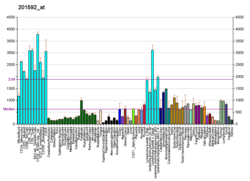
KNOWPIA
WELCOME TO KNOWPIA
Summary
Eukaryotic translation initiation factor 3 subunit H (eIF3h) is a protein that in humans is encoded by the EIF3H gene.[5][6]
| EIF3H | |||||||||||||||||||||||||||||||||||||||||||||||||||
|---|---|---|---|---|---|---|---|---|---|---|---|---|---|---|---|---|---|---|---|---|---|---|---|---|---|---|---|---|---|---|---|---|---|---|---|---|---|---|---|---|---|---|---|---|---|---|---|---|---|---|---|
| |||||||||||||||||||||||||||||||||||||||||||||||||||
| Identifiers | |||||||||||||||||||||||||||||||||||||||||||||||||||
| Aliases | EIF3H, EIF3S3, eIF3-gamma, eIF3-p40, eukaryotic translation initiation factor 3 subunit H | ||||||||||||||||||||||||||||||||||||||||||||||||||
| External IDs | OMIM: 603912 MGI: 1915385 HomoloGene: 2785 GeneCards: EIF3H | ||||||||||||||||||||||||||||||||||||||||||||||||||
| |||||||||||||||||||||||||||||||||||||||||||||||||||
| |||||||||||||||||||||||||||||||||||||||||||||||||||
| |||||||||||||||||||||||||||||||||||||||||||||||||||
| |||||||||||||||||||||||||||||||||||||||||||||||||||
| |||||||||||||||||||||||||||||||||||||||||||||||||||
| Wikidata | |||||||||||||||||||||||||||||||||||||||||||||||||||
| |||||||||||||||||||||||||||||||||||||||||||||||||||
Interactions edit
See also edit
References edit
- ^ a b c GRCh38: Ensembl release 89: ENSG00000147677 – Ensembl, May 2017
- ^ a b c GRCm38: Ensembl release 89: ENSMUSG00000022312 – Ensembl, May 2017
- ^ "Human PubMed Reference:". National Center for Biotechnology Information, U.S. National Library of Medicine.
- ^ "Mouse PubMed Reference:". National Center for Biotechnology Information, U.S. National Library of Medicine.
- ^ Asano K, Vornlocher HP, Richter-Cook NJ, Merrick WC, Hinnebusch AG, Hershey JW (Nov 1997). "Structure of cDNAs encoding human eukaryotic initiation factor 3 subunits. Possible roles in RNA binding and macromolecular assembly". J. Biol. Chem. 272 (43): 27042–52. doi:10.1074/jbc.272.43.27042. PMID 9341143.
- ^ "Entrez Gene: EIF3S3 eukaryotic translation initiation factor 3, subunit 3 gamma, 40kDa".
- ^ Ewing RM, Chu P, Elisma F, Li H, Taylor P, Climie S, McBroom-Cerajewski L, Robinson MD, O'Connor L, Li M, Taylor R, Dharsee M, Ho Y, Heilbut A, Moore L, Zhang S, Ornatsky O, Bukhman YV, Ethier M, Sheng Y, Vasilescu J, Abu-Farha M, Lambert JP, Duewel HS, Stewart II, Kuehl B, Hogue K, Colwill K, Gladwish K, Muskat B, Kinach R, Adams SL, Moran MF, Morin GB, Topaloglou T, Figeys D (2007). "Large-scale mapping of human protein-protein interactions by mass spectrometry". Mol. Syst. Biol. 3 (1): 89. doi:10.1038/msb4100134. PMC 1847948. PMID 17353931.
- ^ Mayeur GL, Fraser CS, Peiretti F, Block KL, Hershey JW (Oct 2003). "Characterization of eIF3k: a newly discovered subunit of mammalian translation initiation factor elF3". Eur. J. Biochem. 270 (20): 4133–9. doi:10.1046/j.1432-1033.2003.03807.x. PMID 14519125.
- ^ Block KL, Vornlocher HP, Hershey JW (Nov 1998). "Characterization of cDNAs encoding the p44 and p35 subunits of human translation initiation factor eIF3". J. Biol. Chem. 273 (48): 31901–8. doi:10.1074/jbc.273.48.31901. PMID 9822659.
Further reading edit
- Maruyama K, Sugano S (1994). "Oligo-capping: a simple method to replace the cap structure of eukaryotic mRNAs with oligoribonucleotides". Gene. 138 (1–2): 171–4. doi:10.1016/0378-1119(94)90802-8. PMID 8125298.
- Asano K, Kinzy TG, Merrick WC, Hershey JW (1997). "Conservation and diversity of eukaryotic translation initiation factor eIF3". J. Biol. Chem. 272 (2): 1101–9. doi:10.1074/jbc.272.2.1101. PMID 8995409.
- Méthot N, Rom E, Olsen H, Sonenberg N (1997). "The human homologue of the yeast Prt1 protein is an integral part of the eukaryotic initiation factor 3 complex and interacts with p170". J. Biol. Chem. 272 (2): 1110–6. doi:10.1074/jbc.272.2.1110. PMID 8995410.
- Suzuki Y, Yoshitomo-Nakagawa K, Maruyama K, Suyama A, Sugano S (1997). "Construction and characterization of a full length-enriched and a 5'-end-enriched cDNA library". Gene. 200 (1–2): 149–56. doi:10.1016/S0378-1119(97)00411-3. PMID 9373149.
- Block KL, Vornlocher HP, Hershey JW (1998). "Characterization of cDNAs encoding the p44 and p35 subunits of human translation initiation factor eIF3". J. Biol. Chem. 273 (48): 31901–8. doi:10.1074/jbc.273.48.31901. PMID 9822659.
- Saramäki O, Willi N, Bratt O, Gasser TC, Koivisto P, Nupponen NN, Bubendorf L, Visakorpi T (2001). "Amplification of EIF3S3 gene is associated with advanced stage in prostate cancer". Am. J. Pathol. 159 (6): 2089–94. doi:10.1016/S0002-9440(10)63060-X. PMC 1850612. PMID 11733359.
- Morris JA, Kandpal G, Ma L, Austin CP (2003). "DISC1 (Disrupted-In-Schizophrenia 1) is a centrosome-associated protein that interacts with MAP1A, MIPT3, ATF4/5 and NUDEL: regulation and loss of interaction with mutation". Hum. Mol. Genet. 12 (13): 1591–608. doi:10.1093/hmg/ddg162. PMID 12812986.
- Mayeur GL, Fraser CS, Peiretti F, Block KL, Hershey JW (2003). "Characterization of eIF3k: a newly discovered subunit of mammalian translation initiation factor elF3". Eur. J. Biochem. 270 (20): 4133–9. doi:10.1046/j.1432-1033.2003.03807.x. PMID 14519125.
- Okamoto H, Yasui K, Zhao C, Arii S, Inazawa J (2003). "PTK2 and EIF3S3 genes may be amplification targets at 8q23-q24 and are associated with large hepatocellular carcinomas". Hepatology. 38 (5): 1242–9. doi:10.1053/jhep.2003.50457. PMID 14578863. S2CID 21888517.
- Savinainen KJ, Linja MJ, Saramäki OR, Tammela TL, Chang GT, Brinkmann AO, Visakorpi T (2004). "Expression and copy number analysis of TRPS1, EIF3S3 and MYC genes in breast and prostate cancer". Br. J. Cancer. 90 (5): 1041–6. doi:10.1038/sj.bjc.6601648. PMC 2409619. PMID 14997205.
- Savinainen KJ, Helenius MA, Lehtonen HJ, Visakorpi T (2006). "Overexpression of EIF3S3 promotes cancer cell growth". Prostate. 66 (11): 1144–50. doi:10.1002/pros.20452. PMID 16652384. S2CID 2281409.
- Olsen JV, Blagoev B, Gnad F, Macek B, Kumar C, Mortensen P, Mann M (2006). "Global, in vivo, and site-specific phosphorylation dynamics in signaling networks". Cell. 127 (3): 635–48. doi:10.1016/j.cell.2006.09.026. PMID 17081983. S2CID 7827573.
External links edit
- Overview of all the structural information available in the PDB for UniProt: O15372 (Eukaryotic translation initiation factor 3 subunit H) at the PDBe-KB.








